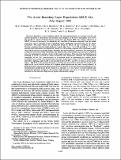| dc.contributor.author | Harriss, R. C. | |
| dc.contributor.author | Wofsy, Steven Charles | |
| dc.contributor.author | Bartlett, D. S. | |
| dc.contributor.author | Shipham, M. C. | |
| dc.contributor.author | Jacob, Daniel James | |
| dc.contributor.author | Hoell, J. M. | |
| dc.contributor.author | Bendura, R. J. | |
| dc.contributor.author | Drewry, J. W. | |
| dc.contributor.author | McNeal, R. J. | |
| dc.contributor.author | Navarro, R. L. | |
| dc.contributor.author | Gidge, R. N. | |
| dc.contributor.author | Rabine, V. E. | |
| dc.date.accessioned | 2015-03-12T18:09:59Z | |
| dc.date.issued | 1992 | |
| dc.identifier.citation | Harriss, R. C., S. C. Wofsy, D. S. Bartlett, M. C. Shipham, D. J. Jacob, J. M. Hoell, R. J. Bendura, et al. 1992. “The Arctic Boundary Layer Expedition (ABLE 3A): July–August 1988.” Journal of Geophysical Research 97 (D15): 16383. doi:10.1029/91jd02109. | en_US |
| dc.identifier.issn | 0148-0227 | en_US |
| dc.identifier.uri | http://nrs.harvard.edu/urn-3:HUL.InstRepos:14121861 | |
| dc.description.abstract | The Arctic Boundary Layer Expedition (ABLE 3A) used measurements from ground, aircraft, and satellite platforms to characterize the chemistry and dynamics of the lower atmosphere over Arctic and sub-Arctic regions of North America during July and August 1988. The primary objectives of ABLE 3A were to investigate the magnitude and variability of methane emissions from the tundra ecosystem, and to elucidate factors controlling ozone production and destruction in the Arctic atmosphere. This paper reports the experimental design for ABLE 3A and a summary of results. Methane emissions from the tundra landscape varied widely from −2.1 to 426 mg CH4 m−2 d−1. Soil moisture and temperature were positively correlated with methane emission rates, indicating quantitative linkages between seasonal climate variability and soil metabolism. Enclosure flux measurement techniques, tower-based eddy correlation, and airborne eddy correlation flux measurements all proved robust for application to methane studies in the tundra ecosystem. Measurements and photochemical modeling of factors involved in ozone production and destruction validated the hypothesized importance of low NOx concentrations as a dominant factor in maintaining the pristine Arctic troposphere as an ozone sink. Stratospheric intrusions, long-range transport of mid-latitude pollution, forest fires, lightning, and aircraft are all potential sources of NOx and NOy to Arctic and sub-Arctic regions. ABLE 3A results indicate that human activities may have already enhanced NOy inputs to the region to the extent that the lifetime of O3 against photochemical loss may have already doubled. A doubling of NOx concentration from present levels would lead to net photochemical production of O3 during summer months in the Arctic (Jacob et al., this issue (a)). The ABLE 3A results indicate that atmospheric chemical changes in the northern high latitudes may serve as unique early warning indicators of the rates and magnitude of global environmental change. | en_US |
| dc.description.sponsorship | Engineering and Applied Sciences | en_US |
| dc.language.iso | en_US | en_US |
| dc.publisher | Wiley-Blackwell | en_US |
| dc.relation.isversionof | doi:10.1029/91JD02109 | en_US |
| dash.license | LAA | |
| dc.title | The Arctic Boundary Layer Expedition (ABLE 3A): July–August 1988 | en_US |
| dc.type | Journal Article | en_US |
| dc.description.version | Version of Record | en_US |
| dc.relation.journal | J. Geophys. Res. | en_US |
| dash.depositing.author | Jacob, Daniel James | |
| dc.date.available | 2015-03-12T18:09:59Z | |
| dc.identifier.doi | 10.1029/91JD02109 | * |
| dash.authorsordered | false | |
| dash.contributor.affiliated | Wofsy, Steven | |
| dash.contributor.affiliated | Jacob, Daniel | |


